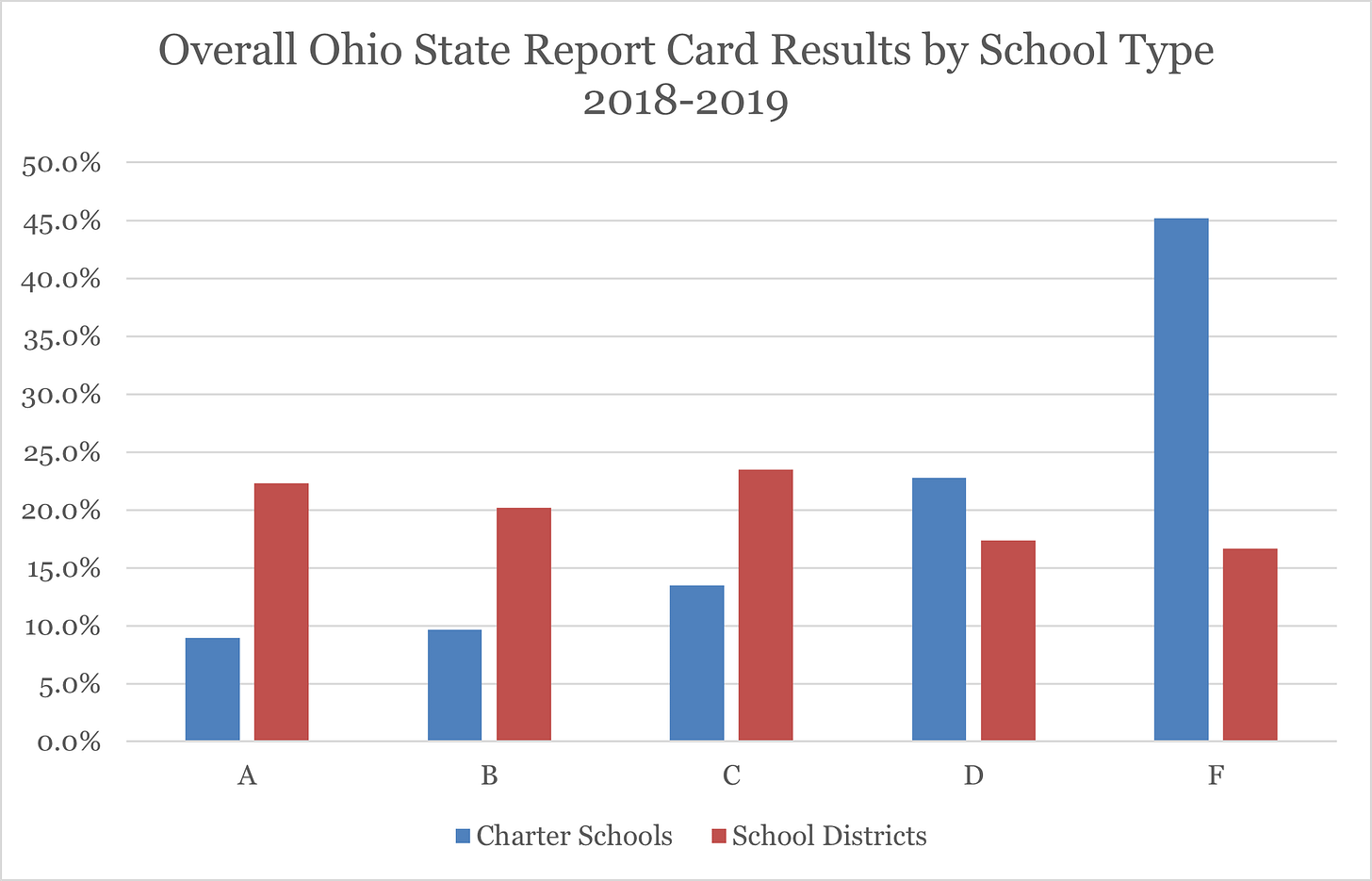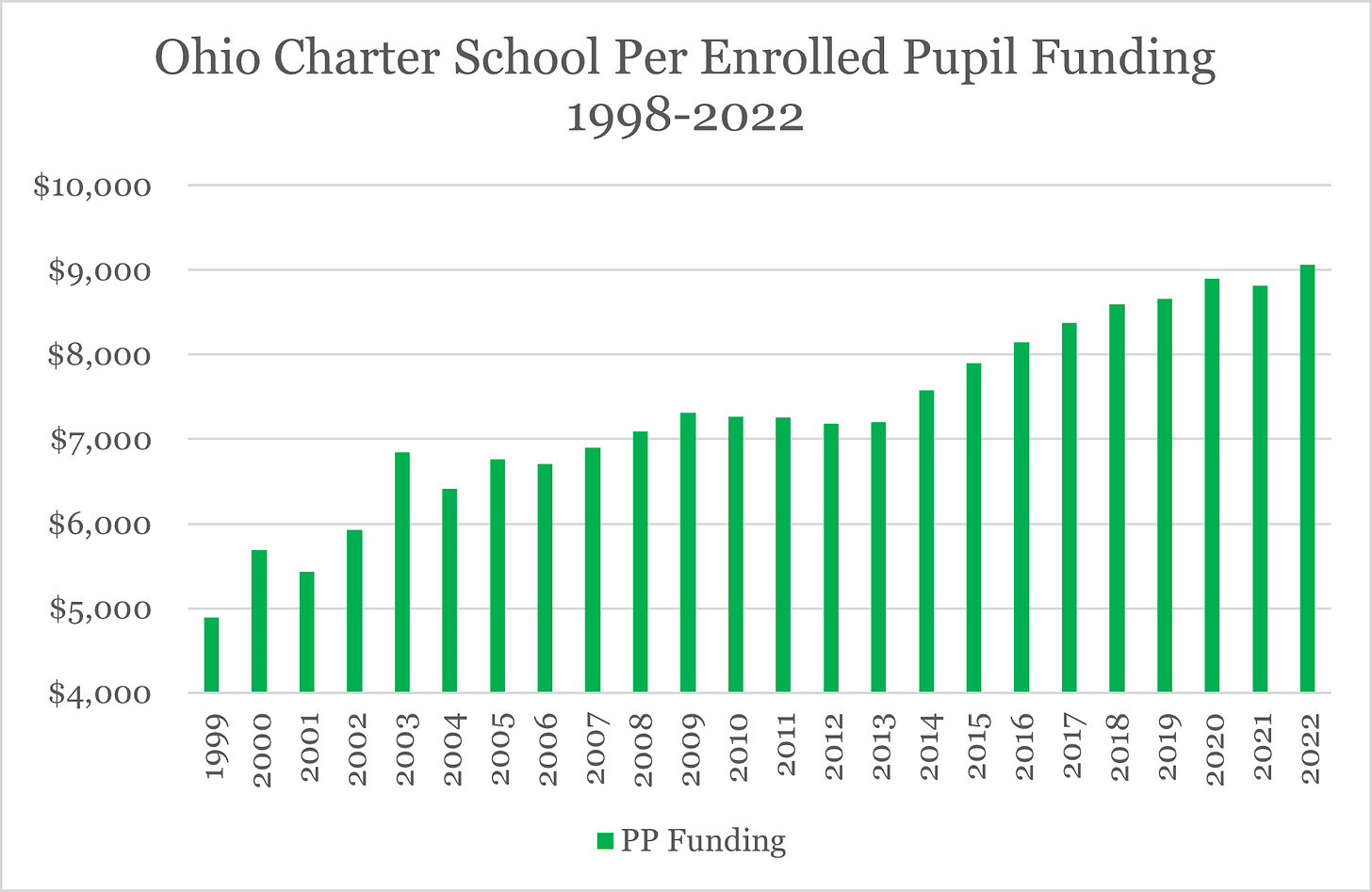Don't Forget!
Ohio Charter Schools gobble up more state funding than ever, despite $200 million ECOT scandal, HB 2 Charter School reform.
I know it’s easy to forget, given all that’s happening with the recent attacks on educators and the meteoric expansion of Ohio’s private school taxpayer tuition subsidies, but folks, Ohio’s charter schools cleared more state funding last year than ever — over $1 billion. And after a slight dip and slowdown around the time of the implosion of the Electronic Classroom of Tomorrow, money to charters is back where it’s always been — relentless and growing.
Just as relentless is Ohio charter schools’ failure to improve their outcomes. But, again, in Ohio high performance has never been a prerequisite for more taxpayer and legislative investment. So let’s take some readings on Ohio’s Charter School sector.
Performance Remains Quite Poor Overall
Charter Schools in Ohio have been among the most notoriously poor performing schools in the entire country. However, there was a hope when the state passed the much-needed House Bill 2 in 2015 that adding those basic checks would improve student and school achievement. Well, that hasn’t really happened. Let’s look at some of the measures (I won’t do straight grade examinations since 2019 because of the very difficult comparisons given COVID’s disruptions).
Graduation Rates
In 2021, Ohio Charter Schools didn’t even graduate 60% of the students that they could have. Meanwhile, districts that have been cited as reasons we need Charter Schools and Vouchers destroyed Charters on this measure. I’ve inserted a chart, but I think it’s important to understand that during the COVID year, Cleveland Municipal School District graduated more than 80% of their students — a remarkable achievement. They graduated students at a 1/3 greater clip that Charter Schools did overall.
Again, what this chart shows is while Ohio’s public school districts did yeoman’s work graduating students during incredibly challenging times, Ohio’s charter schools did worse than even the lowest performing school district, far worse than Ohio’s most challenged urban districts and extraordinarily worse than Ohio’s school districts overall. In fact, if Charter Schools were as good at graduating students as Ohio’s urban districts, 1,200 more students would have diplomas today. Over their lifetimes, that would equate to roughly $480 million in lost wages ($745 million if they could do as well as Ohio’s public school districts overall).
Just from one class of Charter School students.
Horrible. But wait. It used to be even worse.
In 2015 — the year House Bill 2 passed — only 45% of eligible Ohio Charter School students graduated in four years. So in 7 years, Ohio’s Charter Schools have improved their graduation rates by nearly 1/3.
Yet they still graduate students at a 33% worse rate than Ohio’s urban school districts, whose “poor” performance was used to justify Charter Schools in the first place. I know. Mind bending.
College Degrees
Look, I know not everyone goes to college and gets a college degree. However, gaining one does indicate you will make $1 million or more over your lifetime than if you just have a high school degree. So how many Ohio Charter School graduates have a college degree within six years of graduation?
11.6%
That’s right.
Roughly 1 in 10 Ohio Charter School graduates in 2014 have a college degree today. And let’s not forget that less than 1/2 of of eligible Ohio Charter School students even graduated high school in 2014.
Meanwhile, about 39% of students who graduated Ohio school districts in 2014 have a college degree. And while kids in Ohio’s urban school districts received degrees at about 1/2 of that rate, their 15% college graduation rate is about 1/3 better than Ohio charter schools.
In stark terms, it’s clear: If you graduate from Ohio Charter Schools, you are 1/3 less likely to get the million dollar promise of a college degree than if you graduated from one of Ohio’s urban school districts.
Abysmal.
Overall, performance of Ohio’s Charter Schools hasn’t improved all the much and remains a laggard compared with Ohio’s local public schools. Again, it’s difficult to compare test score data given COVID’s challenges, but at the bottom line level — how many of your students get a high school and/or college degree — the performance of Ohio’s Charter Schools remains an embarrassment.
The last non-COVID year (2018-2019) told the same story as has always been told — Ohio School Districts vastly outperform charter schools. By how much? Take a look:
Nearly 7 in 10 Ohio Charter School grades were Ds or Fs. Meanwhile, more than 7 in 10 Ohio school district grades were As, Bs or Cs.
And before you deal with the screams from pro-charter folks about not using all Ohio school districts when comparing performance, in the 2018-2019 school year, all but 3 Ohio districts (island districts and College Corner are considered outlier districts) lost at least some funding to Ohio charter schools. You don’t get to take money from every Ohio school district then cherry pick the smallest, lowest-performing set of schools against which you want your performance to be judged.
Sorry.
All this bad performance hasn’t stopped Ohio’s legislators and governors from continuing to lavish taxpayer money upon these schools.
Funding
Ohio currently has 324 Charter Schools in operation. Since the program started in the 1998-1999 school year, 318 Ohio Charter Schools have closed. Before you think that’s because Ohio’s been tough on accountability, understand that only 24 of those closures have come because they law said they didn’t perform well enough. By far the most frequently cited reason for schools closing has been because of financial issues.
Which is curious because Ohio’s charter schools this current school year receive $9,066 per pupil in state aid to educate their kids. The average Ohio public school student receives $4,944 per pupil in state aid. And while, yes, Charter Schools don’t raise local revenue, that $9,066 is more than Wheelersburg spends per pupil, including local and federal money.
And somehow in the 2020-2021 school year, Ohio Charter Schools found a way to spend, on average, $13,426 per pupil. Ohio’s public school districts’ average?
Not even $20 more per pupil — $13,445.
That’s right. Ohio Charter Schools receive so much more state revenue than Ohio’s public school districts that, on average, it wipes out the need for charters to get local revenue.
And they spend, on average, the same as a typical Ohio School District!
Now that is state commitment!
Want to see how the money has exploded for charters over the years? Thought you might.
You can see that around the time of the infamous Electronic Classroom of Tomorrow scandal (whose potential size dwarfs the infamous First Energy scandal), there was a dropoff in funding, but they’ve rebounded nicely despite the fact they haven’t grown a ton more enrollment.
Why have they collected more than ever, despite modest enrollment drop? State legislative commitment to the growth in their per pupil revenue.
So what is going on? A 23-year-long, methodically committed willingness to drain public tax dollars from Ohio’s public schools and pour them into privately run, worse-performing Charter Schools.
It’s not any more complicated than that. So please. As my grandfather used to say: Don’t forget!







